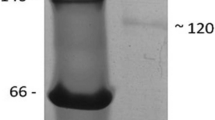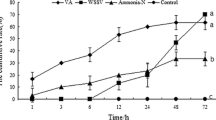Abstract
The pattern recognition proteins (PRPs) play a major role in immune response of crustacean to resist pathogens. In the present study, as one of PRPs, lipopolysaccharide and β-1, 3-glucan binding protein (LGBP) gene in the ridge tail white prawn (Exopalaemon carinicauda) (EcLGBP) was isolated. The full-length cDNA of EcLGBP was 1338 bp, encoding a polypeptide of 366 amino acid residules. The deduced amino acid sequence of EcLGBP shared high similarities with LGBP and BGBP from other crustaceans. Some conservative domains were predicted in EcLGBP sequence. EcLGBP constitutively expressed in most tissues at different levels, and the highest expression was observed in hepatopancreas. With infection time, the cumulative mortality increased gradually followed by the proliferation of Vibrio parahaemolyticus and white spot syndrome virus (WSSV). The expression of EcLGBP in response to V. parahaemolyticus infection was up-regulated in hemocytes and hepatopancreas, and the up-regulation in hepatopancreas was earlier than that in hemocytes. EcLGBP expression after WSSV infection increased at 3 h, then significantly decreased in both hemocytes and hepatopancreas. The results indicated that EcLGBP was involved in the immune defense against bacterial and viral infections.
Similar content being viewed by others
References
Akira, S., Takeda, K., and Kaisho, T., 2001. Toll-like receptors: Critical proteins linking innate and acquired immunity. Nature Immunology, 2(8): 675–680.
Akira, S., Uematsu, S., and Takeuchi, O., 2006. Pathogen recognition and innate immunity. Cell, 124(4): 783–801.
Amparyup, P., Sutthangkul, J., and Charoensapsri, W., 2012. Pattern recognition protein binds to lipopolysaccharide and ß-1, 3-glucan and activates shrimp prophenoloxidase system. The Journal of Biological Chemistry, 287(13): 10060–10069.
Bachère, E., 2000. Shrimp immunity and disease control. Aquaculture, 191: 3–11.
Cheng, W., Liu, C. H., Tsai, C. H., and Chen, J. C., 2005. Molecular cloning and characterization of a pattern recognition molecule, lipopolysaccharide-and ß-1, 3-glucan binding protein (LGBP) from the white shrimp Litopenaeus vannamei. Fish & Shellfish Immunology, 18(4): 297–310.
Christophides, G. K., Vlachou, D., and Kafatos, F. C., 2004. Comparative and functional genomics of the innate immune system in the malaria vector Anopheles gambiae. Immunological Reviews, 198(1): 127–148.
Dimopoulos, G., Richman, A., Müller, H. M., and Kafatos, F. C., 1997. Molecular immune responses of the mosquito Anopheles gambiae to bacteria and malaria parasites. Proceedings of the National Academy of Sciences, 94(21): 11508–11513.
Du, X. J., 2007. Pattern recognition and effectors of innate immunity in Chinese shrimp (Fenneropenaeus chinensis). PhD thesis. Shandong University, Jinan (in Chinese).
Du, X. J., Zhao, X. F., and Wang, J. X., 2007. Molecular cloning and characterization of a lipo-polysaccharide and ß-1, 3-glucan binding protein from fleshy prawn (Fenneropenaeus chinensis). Molecular Immunology, 44: 1085–1094.
Duan, Y. F., Liu, P., Li, J., Li, J., Gao, B. Q., and Chen, P., 2013. cDNA cloning, characterization and expression analysis of peroxiredoxin 5 gene in the ridgetail white prawn Exopalaemon carinicauda. Molecular Biology Reports, 40(12): 6569–6577.
Duvic, B., and Söderhäll, K., 1992. Purification and partial characterization of a ß-1, 3-glucan-binding-protein membrane receptor from blood cells of the crayfish Pacifastacus leniusculus. European Journal of Biochemistry, 207(1): 223–228.
Dziarski, R., 2004. Peptidoglycan recognition proteins (PRGPs). Molecular Immunology, 40: 877–886.
Escobedo-Bonilla, C. M., Audoorn, L., Wille, M., Alday-Sanz, V., Sorgeloos, P., Pensaert, M. B., and Nauwynck, H. J., 2006. Standardized white spot syndrome virus (WSSV) inoculation procedures for intramuscular or oral routes. Diseases of Aquatic Organisms, 68: 181–188.
Figueroa-Pizano, M. D., Peregrino-Uriarte, A. B., Yepiz-Plascencia, G., Martínez-Porchas, M., Gollas-Galván, T., and Martínez-Córdova, L. R., 2014. Gene expression responses of white shrimp (Litopenaeus vannamei) infected with necrotizing hepatopancreatitis bacterium. Aquaculture, 420: 165–170.
Flegel, T. W., 2012. Historic emergence, impact and current status of shrimp pathogens in Asia. Journal of Invertebrate Pathology, 110(2): 166–173.
Flegel, T. W., Lightner, D. V, and Lo, C. F., 2008. Owens L. shrimp disease control: Past, present and future. Diseases in Asian Aquaculture, 4: 355–378.
Ge, Q., Liang, J., Li, J., Li, J., Duan, Y., Zhao, F., and Ren, H., 2015. Molecular cloning and expression analysis of Relish gene from the ridgetail white prawn Exopalaemon carinicauda. Fisheries Science, 81(4): 699–711.
Gross, P. S., Bartlett, T. C., Browdy, C. L., Chapman, R. W., and Warr, G. W., 2001. Immune gene discovery by expressed sequence tag analysis of hemocytes and hepatopancreas in the Pacific white shrimp, Litopenaeus vannamei, and the Atlantic white shrimp, L. setiferus. Developmental & Comparative Immunology, 25(7): 565–577.
He, N. H., Qin, Q. W., and Xu, X., 2005. Differential profile of genes expressed in hemocytes of white spot syndrome virus-resistant shrimp (Penaeus japonicus) by combining suppression subtractive hybridization and differential hybridization. Antiviral Research, 66(1): 39–45.
Holmblad, T., Thörnqvist, P. O., Söderhäll, K., and Johanßson, M. W., 1997. Identification and cloning of an integrin ß subunit from hemocytes of the freshwater crayfish Pacifastacus leniusculus. Journal of Experimental Zoology, 277(3): 255–261.
Jiang, H., Cai, Y. M., Chen, L. Q., Zhang, X. W., Hu, S. N., and Wang, Q., 2009. Functional annotation and analysis of expressed sequence tags from the hepatopancreas of mitten crab (Eriocheir sinensis). Marine Biotechnology, 11(3): 317–326.
Kim, Y. S., Ryu, J. H., Han, S. J., Choi, K. H., Nam, K. B., Jang, I. H., and Lee, W. J., 2000. Gram-negative bacteria-binding protein, a pattern recognition receptor for lipopolysaccharide and ß-1, 3-glucan that mediates the signaling for the induction of innate immune genes in Drosophila melanogaster cells. Journal of Biological Chemistry, 275(42): 32721–32727.
Kwang, J., 2011. Oral vaccination of baculovirus-expressed VP28 displays enhanced protection against white spot syndrome virus in Penaeus monodon. PloS One, 6 (11): e26428.
Leaño, E. M., and Mohan, C. V., 2012. Early mortality syndrome threatens Asia’s shrimp farms. Global Aquaculture Advocate, 2012 (7/8): 38–39.
Lee, S. Y., Wang, R., and Söderhäll, K., 2000. A lipopolysaccharide-and ß-1, 3-glucan-binding protein from hemocytes of the freshwater crayfish Pacifastacus leniusculus purification, characterization, and cDNA cloning. Journal of Biological Chemistry, 275(2): 1337–1343.
Li, F., Wang, D., Li, S., Yan, H., Zhang, J., Wang, B., and Xiang, J., 2010. A dorsal homolog (FcDorsal) in the Chinese shrimp Fenneropenaeus chinensis is responsive to both bacteria and WSSV challenge. Developmental & Comparative Immunology, 34(8): 874–883.
Lin, Y. C., Vaseeharan, B., and Chen, J. C., 2008. Identification and phylogenetic analysis on lipopolysaccharide and ß-1, 3-glucan binding protein (LGBP) of kuruma shrimp Marsupenaeus japonicus. Developmental & Comparative Immunology, 32(11): 1260–1269.
Livak, K. J., and Schmittgen, T. D., 2001. Analysis of relative gene expression data using real-time quantitative PCR and the 2(-delta delta C(T)) method. Methods, 25: 402–408.
Medzhitov, R., and Janeway, C., 2000. Innate immune recognition: Mechanisms and pathways. Immunological Reviews, 173(1): 89–97.
Roux, M. M., Pain, A., Klimper, K. R., and Dhar, A. Y., 2002. The lipopolysaccharide and ß-1, 3-glucan binding protein gene is upregulated in white spot virus-infected shrimp (Penaeus stylirostris). Journal of Virology, 76(14): 7140–7149.
Sánchez-Martínez, J. G., Aguirre-Guzmán, G., and Mejía-Ruiz, H., 2007. White spot syndrome virus in cultured shrimp: A review. Aquaculture Research, 38: 1339–1354.
Spann, K. M., and Lester, R. J. G., 1997. Viral diseases of penaeid shrimp with particular reference to four viruses recently found in shrimp from Queensland. World Journal of Microbiology and Biotechnology, 13(4): 419–426.
Takeuchi, O., and Akira, S., 2010. Pattern recognition receptors and inflammation. Cell, 140(6): 805–820.
Tamura, K., Dudley, J., Nei, M., and Kumar, S., 2007. MEGA4: Molecular evolutionary genetics analysis (MEGA) software version 4.0. Molecular Biology and Evolution, 24(8): 1596–1599.
Taßsanakajon, A., Somboonwiwat, K., Supungul, P., and Tang, S., 2013. Discovery of immune molecules and their crucial functions in shrimp immunity. Fish & Shellfish Immunology, 34: 954–967.
Thörnqvist, P. O., Johansson, M. W., and Söderhäll, K., 1994. Opsonic activity of cell adhesion proteins and ß-1, 3-glucan binding protein from two crustaceans. Developmental and Comparative Immunology, 18: 3–12.
Vargas, A. F., Jiménez, V. F., and Söderhäll, K., 1996. A plasma protein isolated from brown shrimp (Penaeus californiensis) which enhances the activation of prophenoloxidase system by ß-1, 3-glucan. Developmental and Comparative Immunology, 20: 299–306.
Vaseeharan, B., 2012. cDNA cloning, characterization and expreßsion of lipopolysaccharide and ß-1, 3-glucan binding protein (LGBP) gene from the Indian white shrimp Fenneropenaeus indicus. Comparative Biochemistry and Physiology Part A: Molecular & Integrative Physiology, 163(1): 74–81.
Wang, B., Li, F., Luan, W., Xie, Y., Zhang, C., Luo, Z., and Xiang, J., 2008. Comparison of gene expression profiles of Fenneropenaeus chinensis challenged with WSSV and Vibrio. Marine Biotechnology, 10(6): 664–675.
Xia, D. Q., 1999. Biological characteristics and aquaculture technique of Exopalaemon carinicauda. China Fisheries, 3: 42–43 (in Chinese).
Yan, D. C., Dong, S. L., Huang, J., and Zhang, J. S., 2007. White spot syndrome virus (WSSV) transmission from rotifer inoculum to crayfish. Journal of Invertebrate Pathology, 94: 144–148.
Yang, F., He, J., Lin, X., Li, Q., Pan, D., Zhang, X., and Xu, X., 2001. Complete genome sequence of the shrimp white spot bacilliform virus. Journal of Virology, 75(23): 11811–11820.
Yeh, M. S., Chang, C. C., and Cheng, W., 2009. Molecular cloning and characterization of lipopolysaccharide-and ß-1, 3-glucan-binding protein from the giant freshwater prawn Macrobrachium rosenbergii and its transcription in relation to foreign material injection and the molt stage. Fish & Shellfish Immunology, 27: 701–706.
Yeh, S. P., Chen, Y. N., Hsieh, S. L., Cheng, W., and Liu, C. H., 2009. Immune response of white shrimp, Litopenaeus vannamei, after a concurrent infection with white spot syndrome virus and infectious hypodermal and hematopoietic necrosis virus. Fish & Shellfish Immunology, 26(4): 582–588.
Zhang, Y., Jin, S., and Zhao, Q. S., 2010. Cloning and expreßsion pattern analysis of a lipopolysaccharide-and ß-1, 3-glucan-binding protein in Portunus trituberculatus. Zoological Research, 31(6): 587–594 (in Chinese).
Zhao, D., Chen, L., Qin, C., Zhang, H., Wu, P., Li, E., and Qin, J., 2009. Molecular cloning and characterization of the lipopolysaccharide and ß-1, 3-glucan binding protein in Chinese mitten crab (Eriocheir sinensis). Comparative Biochemistry and Physiology Part B: Biochemistry and Molecular Biology, 154(1): 17–24.
Author information
Authors and Affiliations
Corresponding author
Rights and permissions
About this article
Cite this article
Ge, Q., Li, J., Duan, Y. et al. Isolation of prawn (Exopalaemon carinicauda) lipopolysaccharide and β-1, 3-glucan binding protein gene and its expression in responding to bacterial and viral infections. J. Ocean Univ. China 15, 288–296 (2016). https://doi.org/10.1007/s11802-016-2741-2
Received:
Revised:
Accepted:
Published:
Issue Date:
DOI: https://doi.org/10.1007/s11802-016-2741-2




